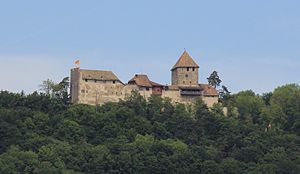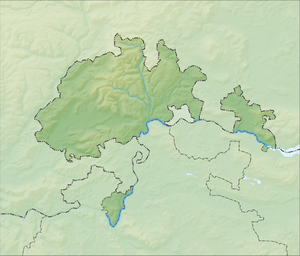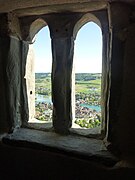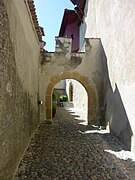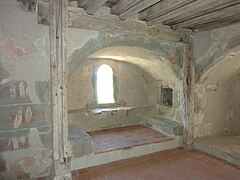Hohenklingen Castle
| Hohenklingen Castle | ||
|---|---|---|
|
Hohenklingen Castle (after renovation in 2008) |
||
| Creation time : | 1225 | |
| Castle type : | Höhenburg, spur location | |
| Conservation status: | Received or received substantial parts | |
| Standing position : | Barons | |
| Place: | Stone at the Rhein | |
| Geographical location | 47 ° 40 '0.7 " N , 8 ° 51' 29.3" E | |
| Height: | 594 m above sea level M. | |
|
|
||
|
Hohenklingen Castle observation tower
|
|
|---|---|
| Basic data | |
| Place: | Stone at the Rhein |
| Canton: | Schaffhausen |
| Country: | Switzerland |
| Altitude : | 594 m |
| Coordinates : | 706631 / 280544 |
| Use: | Observation tower |
| Accessibility: | Observation tower open to the public |
| Tower data | |
| Construction time : | 1254 |
| Building material : | stone |
| Total height : | 29.00 m |
| Viewing platform: | 20.00 m |
The Hohenklingen Castle is a Spur castle in Stein am Rhein in the canton of Schaffhausen in Switzerland . It is located at 594 m above sea level. M. almost 200 meters above the town on a narrow Nagelfluhgrat , the Schiener Berg, running from east to west .
Hohenklingen Castle has been spared warlike destruction in the course of its history. Its silhouette with walls and roofs still corresponds to the medieval appearance from 1200 to 1422.
Surname
The name derives from the Old High German klingo , Middle High German sword , which meant so much as a mountain stream, ravine or rushing water. The name of the high Clingen ob Stain first appears in 1327. It refers to the Bachtobel, which unite at the foot of the castle hill.
history

The history of Hohenklingen Castle is closely linked to the history of the town of Stein am Rhein and the St. Georgen monastery . Around 1200, the caste guard of the monastery, Walter von Klingen , built a residential tower on the site of the current complex . It can be assumed that the former castvögte of the monastery, the Zähringer , had already built a wooden residential tower with a fortification moat in the north, which was taken over and expanded by the barons of Klingen after their extinction.
At the beginning of the 14th century, the von Hohenklingen family split into the Hohenklingen- Brandis and Hohenklingen- Bechburg branches . In 1359 Ulrich and Walter von Hohenklingen-Brandis sold their share in Kastvogtei Castle to Austria for financial reasons and received it back as a fief . In 1419 their descendants sold the fiefdom to Kaspar von Klingenberg , lord of the Hohentwiel Fortress , who in 1433 also bought the other half of the Hohenklingen complex.
In 1457, in the course of the decline of the small nobility, the Klingenbergers had to sell Hohenklingen Castle. The citizens of Stein am Rhein, who paid 24,500 guilders for the castle, acted as buyers. The castle later became an important end point in the chain of the Zurich Hochwachten . A bailiff was appointed; up to the 19th century there were over thirty bailiffs in Hohenklingen. In 1484, the castle and town came under the protection of Zurich , and both were to be open to Zurich residents in the future.
In 1499, at the time of the Swabian War , and from 1618 to 1648 in the Thirty Years' War , the castle played an important role as a military fortification; additional guards and helpers were moved to the castle. After the turn of the 18th and 19th centuries, the festival lost its strategic importance. During the Second World War , a military observation post was set up on the tower.
In 1838 the guard duty was abolished; as a result, the castle threatened to crumble. Attempts to lease the castle failed due to the bankruptcy of the respective tenants. Only the attempt to set up a sanatorium with guest rooms and an inn in the castle brought success after initial difficulties. Today, Hohenklingen Castle with its restaurant (fine cuisine) and wide views is a popular destination.
Building history
Time of the Hohenklingener
The curtain wall and the palace in the west date from the early days of the castle around 1220 . Timber from the previous building, which was demolished around 1212, was also used for the construction. Between 1250 and 1280 the Palas was expanded in the east, the building in the middle with the double kennel in front of it to the north with loopholes and two gates and the tower in the east. The 20 meter high keep has a square base with a side length of around 10 meters. The corner stones are made with carefully worked edges. The high entrance was at a height of 8.5 meters. The keep is now used as a lookout tower.
The shield wall in the east and the chapel, in which the remains of an altar were discovered, date from the period between 1393 and 1406 . The previously open pinnacle was covered with a hipped roof and the wooden middle section was expanded.
Time of the Klingenbergers
The third floor was built above the palace in 1423 with the wooden cladding . This gave the castle its current building volume. The knight's hall in the palace is decorated with modern representations of the coats of arms of the Lords of Hallwyl , Toggenburg , Brandis , Fürstenberg and Austria .
City of Stein am Rhein
Around 1460 the battlements for firearms were built as well as a room for the guards and a detention cell. During the wars of the Reformation between 1526 and 1551, gun emplacements were installed on the tower battlements and in the upper storey . During the Thirty Years War, the eastern part of the central building was rebuilt. The red shop for the guard was built above the castle gate. In 1712 the arbor was installed in front of the tower.
From 1895 to 1897, the town of Stein am Rhein subjected the dilapidated castle to a total renovation. From 2005 to 2007 the castle was again extensively restored. The rooms used as a restaurant were gently adapted to today's requirements. A new lift built into the mountain facilitates access to the castle from the parking lot. The renovation was financially supported by the Jakob and Emma Windler Foundation, the Canton of Schaffhausen and the Swiss Confederation.
gallery
literature
For the latest information see:
- Kurt Bänteli / Erwin Eugster: Hohenklingen Castle above Stein am Rhein, Vol. 1: Archeology and history of the castle and the beginnings of the small town. Schaffhausen Archeology Vol. 8. Schaffhausen 2010.
- Andreas Heege: Hohenklingen ob Stein am Rhein. Vol. 2: Castle, Hochwacht, health resort. Research on material culture from the 12th to the 20th century. Schaffhausen Archeology, Vol. 9. Schaffhausen 2010.
Older research status:
- Fritz Hauswirth: Castles and palaces in Switzerland . Volume 9. Neptun Verlag. Kreuzlingen, 1972, p. 154 ff.
- Werner Meyer : Castles of Switzerland . Volume 5. Silva Verlag. Zurich, 1983. p. 91 ff.
- M. Guisolan: Stein am Rhein . 1998. pp. 73-76.
- Kdm SH 2 . 1958. pp. 304-318.
- D. Reicke: Of strong and great Flüejen . 1995. p. 79 f.
- O. Stiefel: History of Hohenklingen Castle and its owners . 1921.
- Official brochure 2009 of Hohenklingen Castle
Web links
- Cantonal archeology Schaffhausen: Hohenklingen Castle
- Cantonal archeology Schaffhausen: building history
- Heinrich Boxler: Hohenklingen. In: Historical Lexicon of Switzerland .
- Castle world: Hohenklingen Castle
- Hohenklingen Castle on the site of the town of Stein am Rhein
Individual evidence
- ↑ Meaning of the word ( Memento of the original from May 24, 2005 in the Internet Archive ) Info: The archive link was inserted automatically and has not yet been checked. Please check the original and archive link according to the instructions and then remove this notice.
